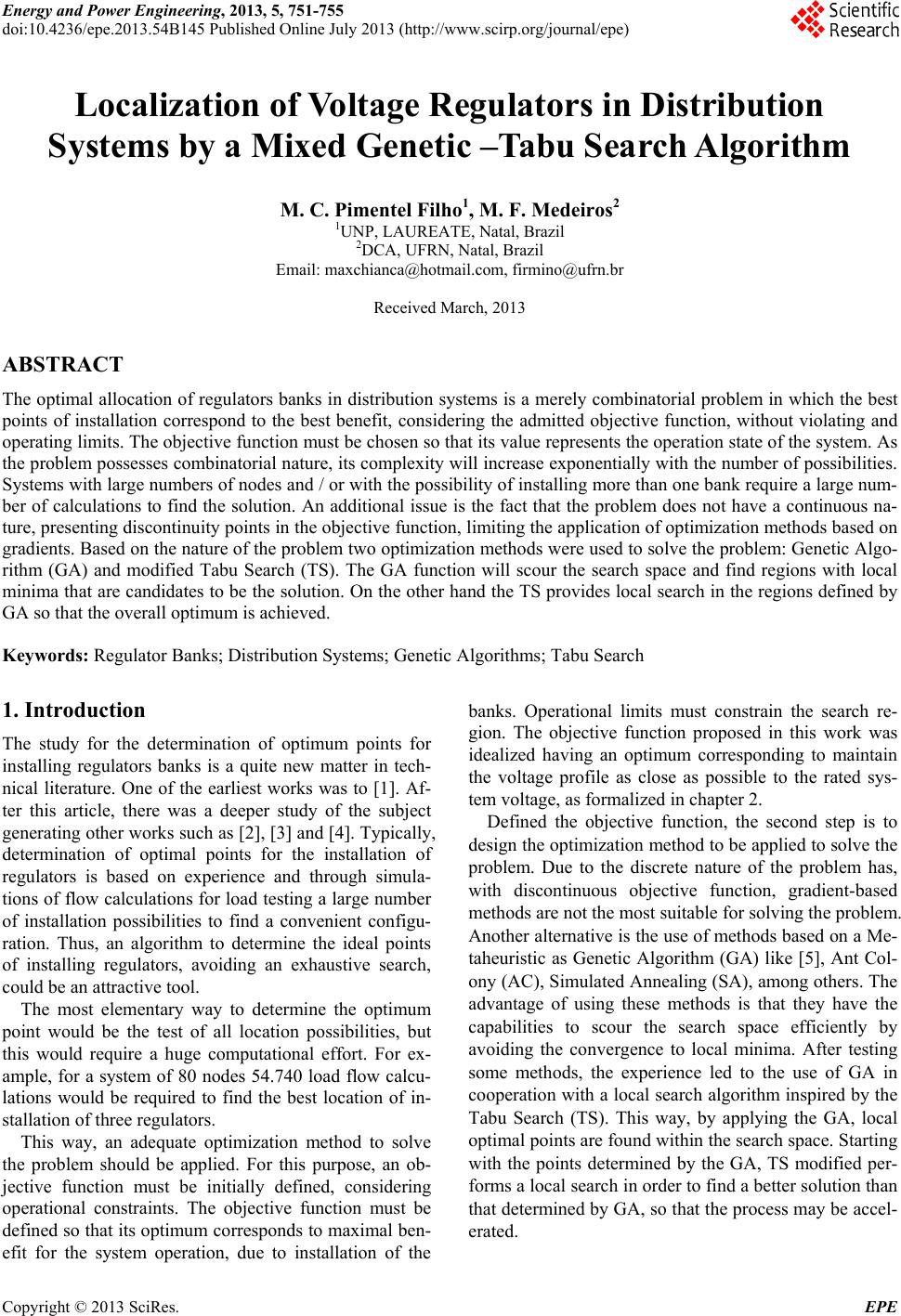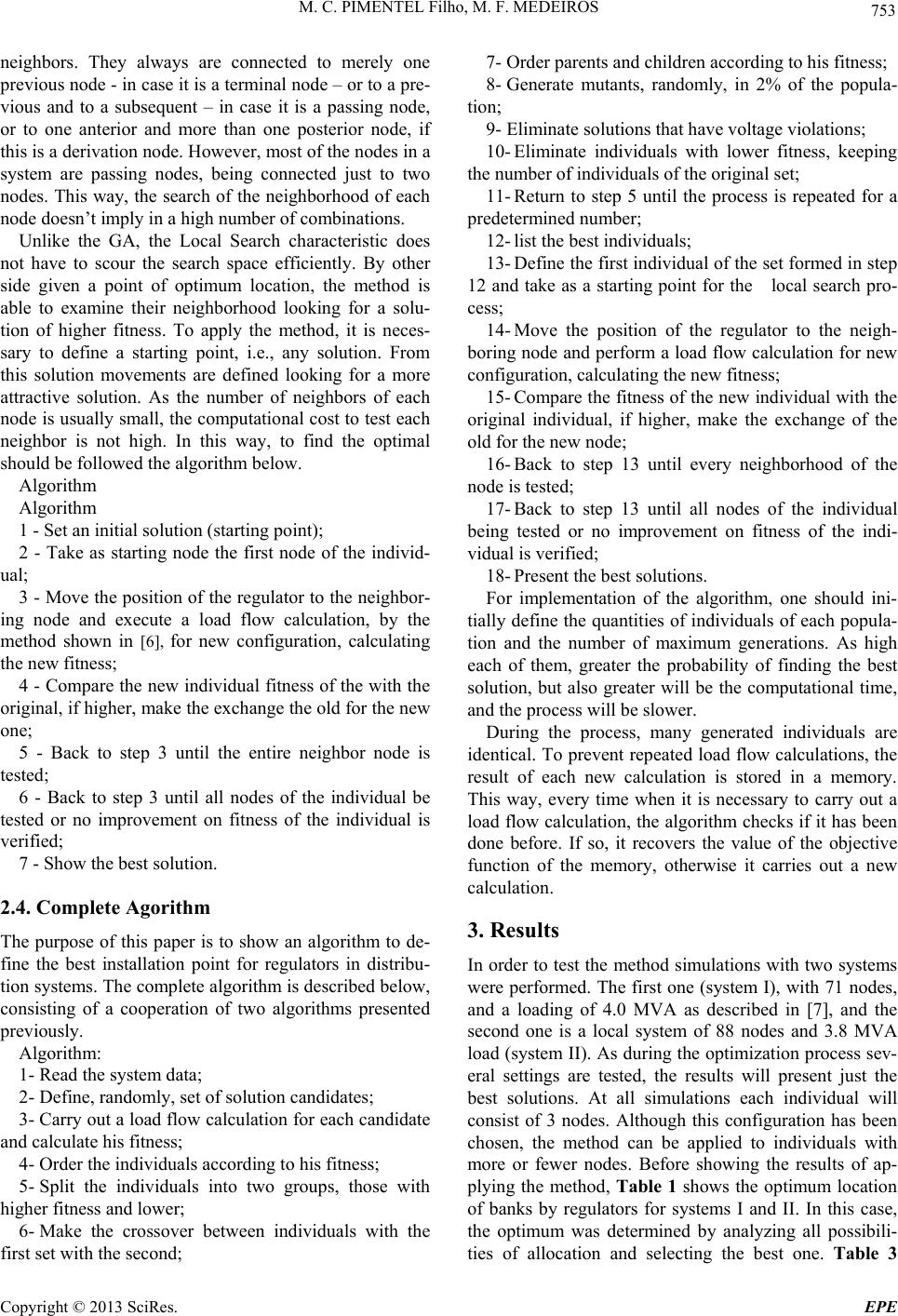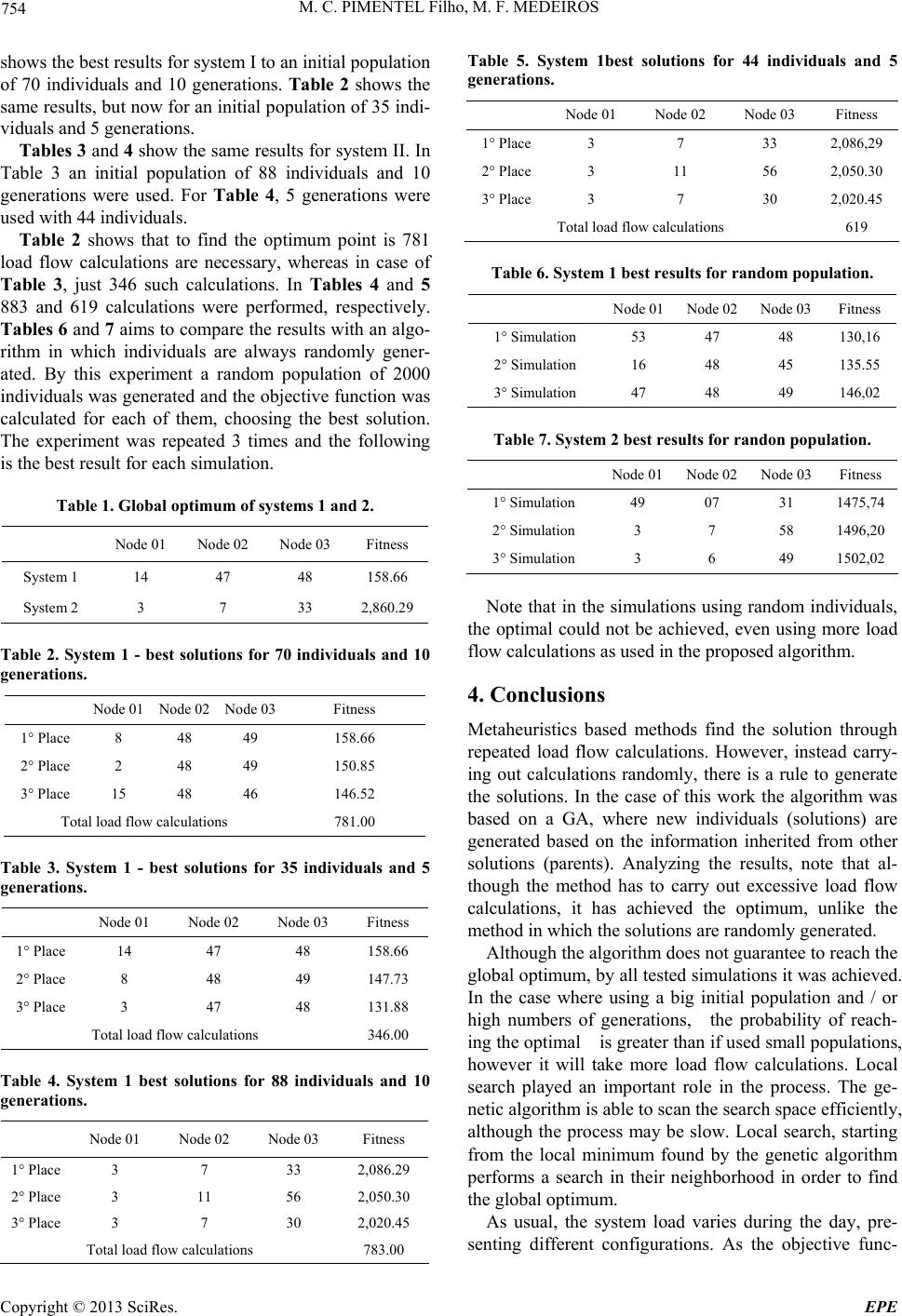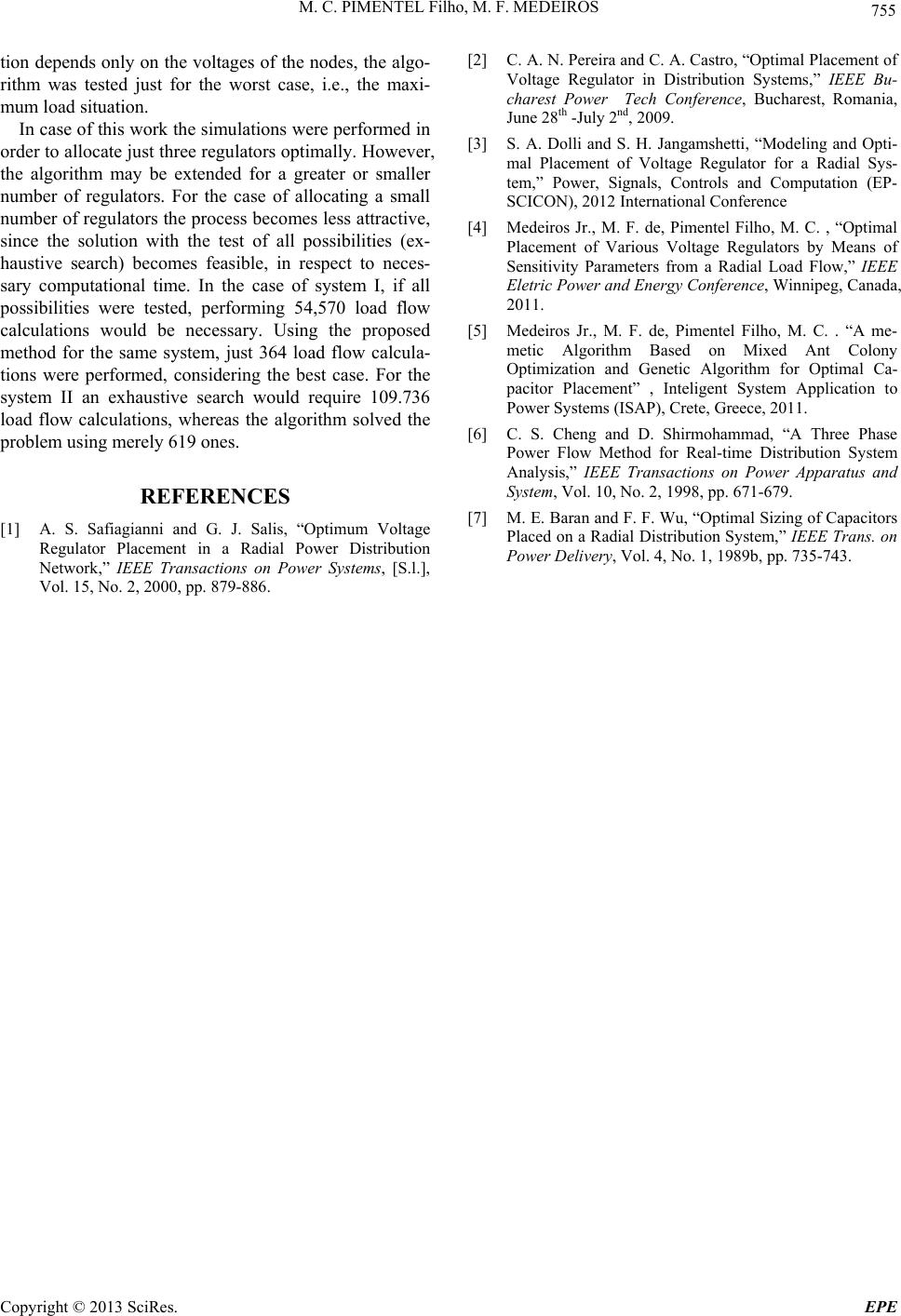Paper Menu >>
Journal Menu >>
 Energy and Power Engineering, 2013, 5, 751-755 doi:10.4236/epe.2013.54B145 Published Online July 2013 (http://www.scirp.org/journal/epe) Localization of Voltage Regulators in Distribution Systems by a Mixed Genetic –Tabu Sear ch Algorithm M. C. Pimentel Filho1, M. F. Medeiros2 1UNP, LAUREATE, Natal, Brazil 2DCA, UFRN, Natal, Brazil Email: maxchianca@hotmail.com, firmino@ufrn.br Received March, 2013 ABSTRACT The optimal allocation of regulato rs banks in distribution systems is a me rely combinatorial prob lem in which the best points of installation correspond to the best benefit, considering the admitted objective function, without violating and operating limits. The obj ective function must be ch osen so that its value represents the operation state of the system. As the problem possesses combinatorial nature, its complexity will increase expon entially with the number of po ssibilities. Systems with large numbers of nodes and / or with the possibility of installin g more than one bank requ ire a large num- ber of calculations to find the solution. An additional issue is the fact that the problem does not have a continuous na- ture, presenting discontinuity points in the objective function, limiting the application of optimization methods based on gradients. Based on the nature of the problem two optimization methods were used to solve the problem: Genetic Algo- rithm (GA) and modified Tabu Search (TS). The GA function will scour the search space and find regions with local minima that are candidates to be the solution. On the other hand the TS provides local search in the regions defined by GA so that the overall optimum is achieved. Keywords: Regulator Banks; Distribution Systems; Genetic Algorithms; Tabu Search 1. Introduction The study for the determination of optimum points for installing regulators banks is a quite new matter in tech- nical literature. One of the earliest works was to [1]. Af- ter this article, there was a deeper study of the subject generating other works such as [2], [3] and [4]. Typically, determination of optimal points for the installation of regulators is based on experience and through simula- tions of flow calculations for load testing a large number of installation possibilities to find a convenient configu- ration. Thus, an algorithm to determine the ideal points of installing regulators, avoiding an exhaustive search, could be an attractive tool. The most elementary way to determine the optimum point would be the test of all location possibilities, but this would require a huge computational effort. For ex- ample, for a system of 80 nodes 54.740 load flow calcu- lations would be required to find the best location of in- stallation of three regulators. This way, an adequate optimization method to solve the problem should be applied. For this purpose, an ob- jective function must be initially defined, considering operational constraints. The objective function must be defined so that its optimum corresponds to maximal ben- efit for the system operation, due to installation of the banks. Operational limits must constrain the search re- gion. The objective function proposed in this work was idealized having an optimum corresponding to maintain the voltage profile as close as possible to the rated sys- tem voltage, as formalized in chapter 2. Defined the objective function, the second step is to design the optimization method to be applied to solve the problem. Due to the discrete nature of the problem has, with discontinuous objective function, gradient-based methods are not the most suitable for solving the problem. Another alternative is the use of methods based on a Me- taheuristic as Genetic Algorithm (GA) like [5], Ant Col- ony (AC), Simulated Annealing (SA), among others. The advantage of using these methods is that they have the capabilities to scour the search space efficiently by avoiding the convergence to local minima. After testing some methods, the experience led to the use of GA in cooperation with a local search algorithm inspired by the Tabu Search (TS). This way, by applying the GA, local optimal points are found within the search space. Starting with the points determined by the GA, TS modified per- forms a local search in order to find a better solution than that determined by GA, so that the process may be accel- erated. Copyright © 2013 SciRes. EPE  M. C. PIMENTEL Filho, M. F. MEDEIROS 752 2. Optimization Method 2.1. Objetive Function The proposed objective function is defined by Equation (01). (01) Submitted to: (02) Maximizing (01) corresponds to search for banks loca- tions that result in all voltages (Vi) closest to the refer- ence voltage (Vref). However some solution candidates may present one or more voltag es below the mini mum. If it happens, the solution will be discarded. Figure 01 illustrates the behavior of the objective function for variation of position of a regulators bank in a distribution system. In this case, the regulators may be installed at all nodes of the main feeder of the distribu- tion system. On the abscissa axis are assigned the nodes where the regulators bank was installed and the ordinates are the values of objective function for each respective installation node. Note that the curve presents points of discontinuity in derivatives, like nodes 05 and 07. Usually these points are nodes of derivations, i.e., where laterals are con- nected. When the regulator is position ed before them, the corresponding lateral is covered b y its effect of rising (or decreasing) voltages. However, when it is placed after this node, the lateral is not contemplated. This is the rea- son for a high increase in the value of the obj ective func- tion near thi s node. 2.2. Genetic Algorithm (GA) The GA sketch begins by defining the individual's con- stitution and the rule of crossover between them. In the case of this study each individual is defined by a set of nodes, each node determining a regulators bank installa- tion point . Figure 2 shows an example of an individual. By the crossover, each child shall be composed by parts of each parent. In the case of individuals formed by 3 nodes, two combinations are possible. Figure 3 shows an example of two parents. Figure 1. Behavior of objection function. For the first possibility, the children generated by the parents are shown in Figure 4. In the second possibility, the children are according Figure 5. Defining criteria for each individual formation and children generation rule, the GA is performed according to the algorithm described below. Algorithm: 1- Generate an initial population randomly; 2- Perform a load flow calculation for each individual and determine the value of the objective function; 3- Order individuals according to their fitness; 4- Split the individuals into two groups, those with higher fitness and lower; 5- Make the crossover between individuals of the first set with the second; 6- Order parents and children according to their fit- ness; 7- Generate mutant 2% of population; 8- Eliminate individuals with lower fitness, keeping the number of individuals in the the original set; 9- Return to step 4 until the process is repeated for a predetermined number; 10- List the best individuals. 2.3. Local Search In radial distribution systems, each node presents few 31020 Figure 2. Example of individual. 31020 81540 Figure 3. Example of parents. 31540 81020 Figure 4. First possibility for crossover. 31040 81520 Figure 5. Second possibility for crossover. Copyright © 2013 SciRes. EPE  M. C. PIMENTEL Filho, M. F. MEDEIROS 753 neighbors. They always are connected to merely one previous nod e - in case it is a terminal node – or to a pre- vious and to a subsequent – in case it is a passing node, or to one anterior and more than one posterior node, if this is a derivation node. However, most of the nodes in a system are passing nodes, being connected just to two nodes. This way, the search of the neighborhood of each node doesn’t imply in a high number of combinations. Unlike the GA, the Local Search characteristic does not have to scour the search space efficiently. By other side given a point of optimum location, the method is able to examine their neighborhood looking for a solu- tion of higher fitness. To apply the method, it is neces- sary to define a starting point, i.e., any solution. From this solution movements are defined looking for a more attractive solution. As the number of neighbors of each node is usually small, the computation al cost to test each neighbor is not high. In this way, to find the optimal should be followed the algorithm below. Algorithm Algorithm 1 - Set an initial solution (starting point); 2 - Take as starting node the first node of the individ- ual; 3 - Move the position of the regulator to the neighbor- ing node and execute a load flow calculation, by the method shown in [6], for new configuration, calculating the new fitness; 4 - Compare the new individual fitness of the with the original, if higher, make the exchange the old for the new one; 5 - Back to step 3 until the entire neighbor node is tested; 6 - Back to step 3 until all nodes of the individual be tested or no improvement on fitness of the individual is verified; 7 - Show the best solution. 2.4. Complete Agorithm The purpose of this paper is to show an algorithm to de- fine the best installation point for regulators in distribu- tion systems. The complete algorithm is described below, consisting of a cooperation of two algorithms presented previously. Algorithm: 1- Read the system data; 2- Define, randomly, set of solution candidates; 3- Carry out a load flow calculation for each candidate and calculate his fitness; 4- Order the individuals according to his fitness; 5- Split the individuals into two groups, those with higher fitness and lower; 6- Make the crossover between individuals with the first set with the second; 7- Order parents and children according to his fitness; 8- Generate mutants, randomly, in 2% of the popula- tion; 9- Eliminate solutions that have voltage violations; 10- Eliminate individuals with lower fitness, keeping the number of individuals of the original set; 11- Return to step 5 until the process is repeated for a predetermined number; 12- list the best individu als; 13- Define the first individual of the set formed in step 12 and take as a starting point for the local search pro- cess; 14- Move the position of the regulator to the neigh- boring node and perform a load flow calculation for new configuration, calculating the new fitness; 15- Compare the fitness of the new individual with the original individual, if higher, make the exchange of the old for the ne w n ode ; 16- Back to step 13 until every neighborhood of the node is tested; 17- Back to step 13 until all nodes of the individual being tested or no improvement on fitness of the indi- vidual is verified; 18- Present the best solutions. For implementation of the algorithm, one should ini- tially define the quantities of individuals of each popula- tion and the number of maximum generations. As high each of them, greater the probability of finding the best solution, but also greater will be the computational time, and the process will be slower. During the process, many generated individuals are identical. To prevent repeated load flow calculations, the result of each new calculation is stored in a memory. This way, every time when it is necessary to carry out a load flow calculation, the algorithm checks if it has been done before. If so, it recovers the value of the objective function of the memory, otherwise it carries out a new calculation. 3. Results In order to test the method simulations with two systems were performed. The first one (system I), with 71 nodes, and a loading of 4.0 MVA as described in [7], and the second one is a local system of 88 nodes and 3.8 MVA load (system II). As during the optimization process sev- eral settings are tested, the results will present just the best solutions. At all simulations each individual will consist of 3 nodes. Although this configuration has been chosen, the method can be applied to individuals with more or fewer nodes. Before showing the results of ap- plying the method, Table 1 shows the optimum location of banks by regulators for systems I and II. In this case, the optimum was determined by analyzing all possibili- ties of allocation and selecting the best one. Table 3 Copyright © 2013 SciRes. EPE  M. C. PIMENTEL Filho, M. F. MEDEIROS 754 shows the best results for system I to an initial popu lation of 70 individuals and 10 generations. Table 2 shows the same results, but now for an initial population of 35 indi- viduals and 5 generations. Tables 3 and 4 show the same results for system II. In Table 3 an initial population of 88 individuals and 10 generations were used. For Table 4, 5 generations were used with 44 individuals. Table 2 shows that to find the optimum point is 781 load flow calculations are necessary, whereas in case of Table 3, just 346 such calculations. In Tables 4 and 5 883 and 619 calculations were performed, respectively. Tables 6 and 7 aims to compare the results with an algo- rithm in which individuals are always randomly gener- ated. By this experiment a random population of 2000 individuals was generated and the objective function was calculated for each of them, choosing the best solution. The experiment was repeated 3 times and the following is the best result for each simulation. Table 1. Global optimum of systems 1 and 2. Node 01 Node 02 Node 03 Fitness System 1 14 47 48 158.66 System 2 3 7 33 2,860.29 Table 2. System 1 - best solutions for 70 individuals and 10 generations. Node 01 Node 02 Node 03 Fi tness 1° Place 8 48 49 158.66 2° Place 2 48 49 150.85 3° Place 15 48 46 146.52 Total load flow calcula tions 781.00 Table 3. System 1 - best solutions for 35 individuals and 5 generations. Node 01 Node 02 Node 03 Fitness 1° Place 14 47 48 158.66 2° Place 8 48 49 147.73 3° Place 3 47 48 131.88 Total load flow calcula tions 346.00 Table 4. System 1 best solutions for 88 individuals and 10 generations. Node 01 Node 02 Node 03 Fitness 1° Place 3 7 33 2,086.29 2° Place 3 11 56 2,050.30 3° Place 3 7 30 2,020.45 Total load flow calculations 783.00 Table 5. System 1best solutions for 44 individuals and 5 generations. Node 01 Node 02 Node 03 Fitness 1° Place 3 7 33 2,086,29 2° Place 3 11 56 2,050.30 3° Place 3 7 30 2,020.45 Total load flow calculations 619 Table 6. System 1 best results for random population. Node 01Node 02 Node 03Fi tness 1° Simulation 53 47 48 130,16 2° Simulation 16 48 45 135.55 3° Simulation 47 48 49 146,02 Table 7. System 2 best results for randon popu lation. Node 01Node 02 Node 03Fitness 1° Simulation 49 07 31 1475,74 2° Simulation 3 7 58 1496, 20 3° Simulation 3 6 49 1502, 02 Note that in the simulations using random individuals, the optimal could not be achieved, even using more load flow calculations as used in the proposed algorithm. 4. Conclusions Metaheuristics based methods find the solution through repeated load flow calculations. However, instead carry- ing out calculations randomly, there is a rule to generate the solutions. In the case of this work the algorithm was based on a GA, where new individuals (solutions) are generated based on the information inherited from other solutions (parents). Analyzing the results, note that al- though the method has to carry out excessive load flow calculations, it has achieved the optimum, unlike the method in which the solutions are randomly generated. Although the algorithm does not guarantee to reach the global optimum, by all tested simulations it was achieved. In the case where using a big initial population and / or high numbers of generations, the probability of reach- ing the optimal is greater than if used small populations, however it will take more load flow calculations. Local search played an important role in the process. The ge- netic algorithm is able to scan the search space efficiently, although the process may be slow. Local search, starting from the local minimum found by the genetic algorithm performs a search in their neighborhood in order to find the global optimum. As usual, the system load varies during the day, pre- senting different configurations. As the objective func- Copyright © 2013 SciRes. EPE  M. C. PIMENTEL Filho, M. F. MEDEIROS Copyright © 2013 SciRes. EPE 755 tion depends only on the voltages of the nodes, the algo- rithm was tested just for the worst case, i.e., the maxi- mum load situation. In case of this work the simulations were performed in order to allocate just three regulators op timally. However, the algorithm may be extended for a greater or smaller number of regulators. For the case of allocating a small number of regulators the process becomes less attractive, since the solution with the test of all possibilities (ex- haustive search) becomes feasible, in respect to neces- sary computational time. In the case of system I, if all possibilities were tested, performing 54,570 load flow calculations would be necessary. Using the proposed method for the same system, just 364 load flow calcula- tions were performed, considering the best case. For the system II an exhaustive search would require 109.736 load flow calculations, whereas the algorithm solved the problem using merely 619 ones. REFERENCES [1] A. S. Safiagianni and G. J. Salis, “Optimum Voltage Regulator Placement in a Radial Power Distribution Network,” IEEE Transactions on Power Systems, [S.l.], Vol. 15, No. 2, 2000, pp. 879-886. [2] C. A. N. Pereira and C. A. Castro, “Optimal Placement of Voltage Regulator in Distribution Systems,” IEEE Bu- charest Power Tech Conference, Bucharest, Romania, June 28th -July 2nd, 2009. [3] S. A. Dolli and S. H. Jangamshetti, “Modeling and Opti- mal Placement of Voltage Regulator for a Radial Sys- tem,” Power, Signals, Controls and Computation (EP- SCICON), 2012 International Conference [4] Medeiros Jr., M. F. de, Pimentel Filho, M. C. , “Optimal Placement of Various Voltage Regulators by Means of Sensitivity Parameters from a Radial Load Flow,” IEEE Eletric Power and Energy Conference, Winnipeg, Canada, 2011. [5] Medeiros Jr., M. F. de, Pimentel Filho, M. C. . “A me- metic Algorithm Based on Mixed Ant Colony Optimization and Genetic Algorithm for Optimal Ca- pacitor Placement” , Inteligent System Application to Power Systems (ISAP), Crete, Greece, 2011. [6] C. S. Cheng and D. Shirmohammad, “A Three Phase Power Flow Method for Real-time Distribution System Analysis,” IEEE Transactions on Power Apparatus and System, Vol. 10, No. 2, 1998, pp. 671-679. [7] M. E. Baran a nd F. F. Wu, “Optimal Sizing of Capacitors Placed on a Radial Distribution System,” IEEE Trans. on Power Delivery, Vol. 4, No. 1, 1989b, pp. 735-743. |

